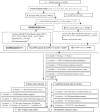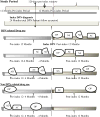Opioid use in the management of diabetic peripheral neuropathy (DPN) in a large commercially insured population
- PMID: 25853725
- PMCID: PMC4391274
- DOI: 10.1097/AJP.0000000000000124
Opioid use in the management of diabetic peripheral neuropathy (DPN) in a large commercially insured population
Abstract
Objective: To examine the proportion of diabetic peripheral neuropathy (DPN) patients receiving pharmacologic DPN treatments and specifically to identify the rates and factors associated with opioid use and first-line opioid use.
Methods: A 10% sample of IMS-LifeLink claims data from 1998 through 2008 was used. The study population consisted of diabetic patients who met DPN criteria using a validated DPN algorithm. Multivariable logistic regression controlling for demographics, comorbidities, and other clinical characteristics was used to identify factors associated with any DPN pharmacologic treatment, any opioid use, and first-line opioid treatment. Sensitivity analyses were conducted to explore variations in exclusion criteria as well as opioid use definitions.
Results: A total of 666 DPN patients met inclusion criteria and pharmacologic treatment was received by 288 patients (43.24%) and of those, 154 (53.47%) had DPN-related opioid use and 96 (33.33%) received opioid as first-line treatment. Persons with diabetic complications were more likely to use opioids (odds ratio=4.53; 95% confidence interval, 1.09-18.92). Food and Drug Administration-approved DPN agents duloxetine 1.04% (n=3) and pregabalin 5.56% (n=16) had much lower rates of use. DPN-related drug use and DPN-related opioid usage increased as we used less restrictive samples in sensitivity analyses.
Conclusions: Opioids were the most frequently prescribed first-line agents for DPN. More than 50% of DPN patients remained untreated with pharmacologic agents 1 year after a DPN diagnosis.
Figures
References
-
- Tesfaye S, Stevens LK, Stephenson JM, et al. Prevalence of diabetic peripheral neuropathy and its relation to glycaemic control and potential risk factors: the EURODIAB IDDM Complications Study. Diabetologia. 1996;39:1377–1384. - PubMed
-
- Gordois A, Scuffham P, Shearer A, et al. The health care costs of diabetic peripheral neuropathy in the US. Diabetes Care. 2003;26:1790–1795. - PubMed
-
- Dyck PJ, Kratz KM, Karnes JL, et al. The prevalence by staged severity of various types of diabetic neuropathy, retinopathy, and nephropathy in a population-based cohort: the Rochester Diabetic Neuropathy Study. Neurology. 1993;43:817–824. - PubMed
-
- Sadosky A, McDermott AM, Brandenburg NA, et al. A review of the epidemiology of painful diabetic peripheral neuropathy, postherpetic neuralgia, and less commonly studied neuropathic pain conditions. Pain Pract. 2008;8:45–56. - PubMed
Publication types
MeSH terms
Substances
Grants and funding
LinkOut - more resources
Full Text Sources
Other Literature Sources
Medical
Miscellaneous



